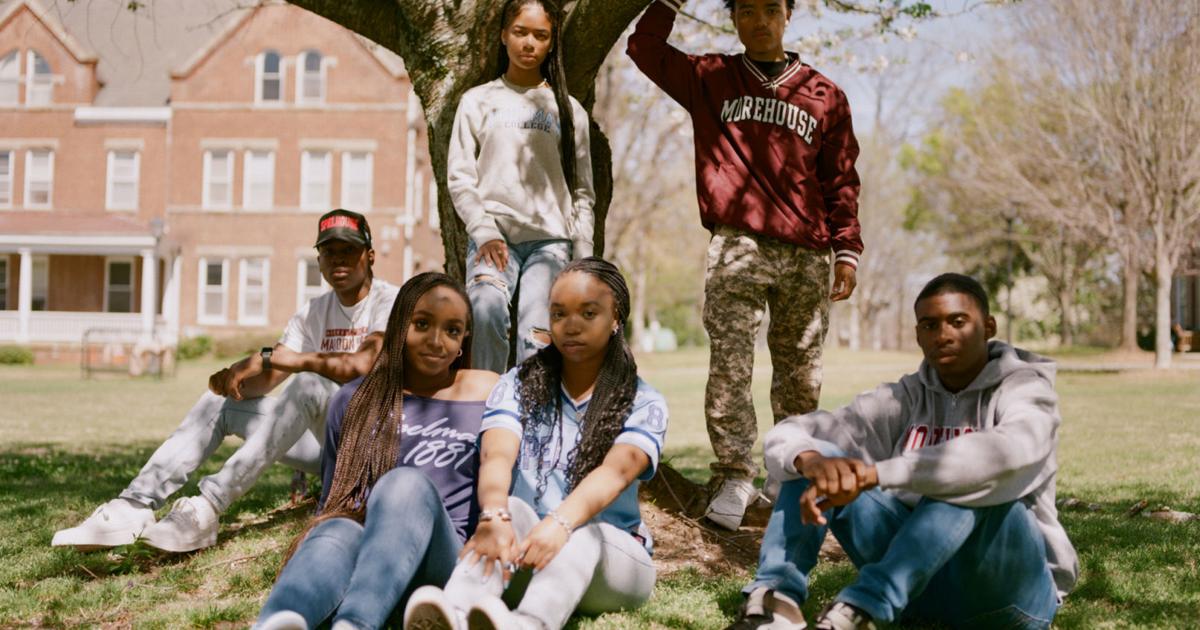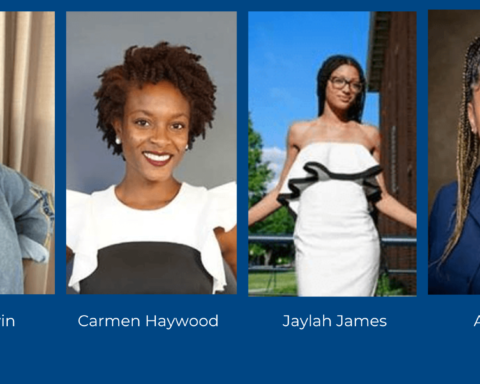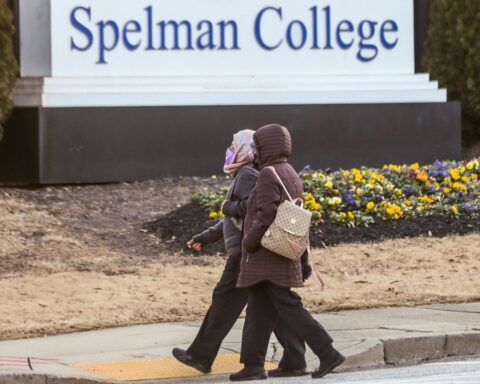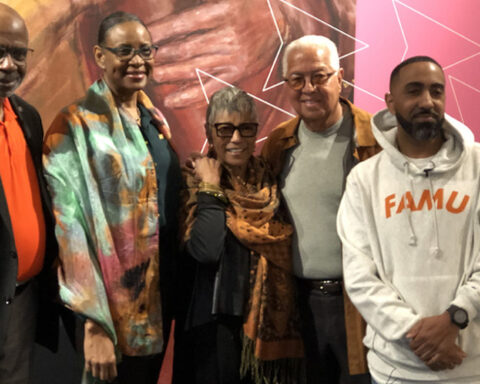By Erica L. Green
SeKai Parker looked on last spring as her prep school classmates tearfully embraced and belted out in unison every word of a Kelly Clarkson song.
It was the senior farewell at Holton-Arms in Bethesda, Md., and many of the teens were making college plans that would have them trading one elite, mostly white setting for another. Ms. Parker intended to accept an offer from Yale, which she had fallen in love with on a recent visit. But as she scanned her school auditorium, a familiar sinking feeling washed over her.
“I was sitting there by myself, I didn’t know a single word and I had no one to hold onto,” she recalled.
After school that day, she rushed out to meet her mother and made a life-changing declaration: I’m going to Spelman.
Choosing the historically Black women’s college in Atlanta was surprising for a student who had been determined to reach the Ivy League. Yale was one of 16 institutions, including three Ivies, competing for her to enroll.
But her decision reflects a renaissance in recent years among the nation’s historically Black colleges and universities, where their nurturing mission, increased funding and growing visibility have been drawing a new wave of students.
Once the primary means for Black Americans to get a college education, historically Black colleges and universities, or H.B.C.U.s, now account for just 9 percent of such students. But top-tier H.B.C.U.s — long bastions of Black excellence — as well as others are increasingly becoming the first choice for some of the nation’s most sought-after talent, according to interviews with dozens of students, guidance counselors, admissions advisers and college officials across the country.
They belong to a generation whose adolescence was shaped not only by the election of the first Black president but also by political and social strife that threatened the lives and liberties of Black Americans. For many families, the embrace of historically Black colleges has been influenced by concerns about racial hostility, students’ feelings of isolation in predominantly white schools and shifting views on what constitutes the pinnacle of higher education.
“College is the time when you’re trying to figure out who you are,” Ms. Parker said in an interview. “It’s impossible to figure that out in a space where you not only feel like you have to assimilate to fit into that space, when they didn’t invite you there or they tolerate you there, but you have to prove that your existence has value.”
They belong to a generation whose adolescence was shaped not only by the election of the first Black president but also by political and social strife that threatened the lives and liberties of Black Americans. For many families, the embrace of historically Black colleges has been influenced by concerns about racial hostility, students’ feelings of isolation in predominantly white schools and shifting views on what constitutes the pinnacle of higher education.
“College is the time when you’re trying to figure out who you are,” Ms. Parker said in an interview. “It’s impossible to figure that out in a space where you not only feel like you have to assimilate to fit into that space, when they didn’t invite you there or they tolerate you there, but you have to prove that your existence has value.”
“We say this is a renaissance for H.B.C.U.s, but the level of clout and capital the institutions have now is unprecedented,” Mr. Murray said, adding, “Frankly, it is about time.”
Lisa Fuller, the owner of College Primed, a college advising firm, noticed the new surge of interest in the schools around 2015, as protests erupted in the streets and on college campuses, when many more parents requested that she add H.B.C.U.s to their children’s lists of college applications.
“Families started to look and be introspective about ‘Where are we sending our kids?’ and started to search for safe havens,” she said. “Students asked, ‘Do I go somewhere where it’s sink or swim, or do I go somewhere where everybody’s swimming with me?’”
When it came time for her son to apply to colleges, Dr. Makunda Abdul-Mbacke thought it was settled: She had gone to Yale as an undergraduate and medical student, and earned a master’s in public health from Harvard. Her son, Khadim Mbacke, was on the radar of Ivy League and other highly selective schools.
“When we talked about what schools we were interested in, he said he wanted to look at Morehouse and Howard, and I was like, ‘What?’” she recalled.
She had imagined him in New Haven, eating in the same dining halls and studying in the same classrooms she had. But she realized how different his experience as a Black male today would be from hers as a young woman in the 1970s, when hard-won gains of the Civil Rights movement were taking hold.
Mr. Mbacke was 16 when neo-Nazis rallied in Charlottesville in August 2017, marching with torches on the University of Virginia, a school he was considering. Violence broke out the next day, leaving one woman dead. At his rural Virginia high school, he noticed overwhelmingly white enrollment in advanced placement courses. “One of the main things was that to be Black and smart, for some reason they tried to make it like those two things couldn’t coexist,” he said.
Then in 2019, a tour guide at the University of Pittsburgh pointed out a blue light emergency alarm system for students to summon security. The beacon was supposed to symbolize safety. For Mr. Mbacke, though, it conjured thoughts of a different outcome should his towering presence on campus ever be seen as a threat. “He’s 6-foot-3,” his mother said. “That’s the description of every Black man they put on the news.”
But after seeing Morehouse College in Atlanta, he was beaming, she recalled.
“His coming-of-age has been Mike Brown and Trayvon Martin and all the litany of young Black men that looked like him that have been killed too soon and taken away from their mothers and their families,” Dr. Abdul-Mbacke said. “There’s no golden key, no golden ticket when you’re Black in America,” she added. “You’re going to have to work hard, and if you can have a fair chance then you go for it. And he found that space.”
The Missouri Effect
America’s first Black college, called the African Institute, was opened in Philadelphia in 1837 by a Quaker philanthropist. Later renamed Cheyney University, it had a mission to train teachers and prepare workers for trades. After the Civil War, dozens of such schools for the formerly enslaved and their children began to populate the southern states, sustained by federal land grants, freedmen’s societies, churches and benefactors.
Over their history, H.B.C.U.s have educated most of the nation’s Black judges, half of its Black doctors and 40 percent of the Black members of Congress, as well as the current vice president, Kamala Harris. Though the schools — from research institutions to two-year programs — make up only 3 percent of the country’s colleges and universities, they produce 13 percent of all African American graduates, according to the United Negro College Fund.
Still, over the past half-century many Black students were drawn to predominantly white colleges and universities, which heavily recruited as they integrated, offering financial incentives and better resources.
That led to eroding enrollment at H.B.C.U.s — 279,000 students as of 2020, the most recent data available — and a perception, even in the Black community, that they were a second-rate option. “We had to our great detriment, and perhaps even our peril, accepted the narrative, ‘white is right,’” said Roslyn Artis, president of Benedict College in Columbia, S.C.
But in recent years, she said, the schools have been widely recognized for what they have always done: “punch above their weight.”
Still, over the past half-century many Black students were drawn to predominantly white colleges and universities, which heavily recruited as they integrated, offering financial incentives and better resources.
That led to eroding enrollment at H.B.C.U.s — 279,000 students as of 2020, the most recent data available — and a perception, even in the Black community, that they were a second-rate option. “We had to our great detriment, and perhaps even our peril, accepted the narrative, ‘white is right,’” said Roslyn Artis, president of Benedict College in Columbia, S.C.
But in recent years, she said, the schools have been widely recognized for what they have always done: “punch above their weight.”
Data showing how many students are applying only to H.B.C.U.s or have turned down majority-white schools in favor of historically Black schools is not available. Just as the most selective H.B.C.U.s are drawing more applicants, so are some of the nation’s other schools. The dean of undergraduate admissions at Yale, for instance, said the school had a record level of Black freshman enrollment the year Ms. Parker declined. The dean, Jeremiah Quinlan, said he knew of one other Black student admitted last year who had opted for an H.B.C.U., noting that there may have been more: Not all students share their plans when they decline an offer.
Jonathan Holloway, the president of Rutgers and a historian, said the Missouri effect — which he experienced as the first Black dean at Yale College — coupled with what he called the “socially permeated pain” of police killings and racial hostility, forced majority-white schools to realize that mere diversity through admissions was not enough.
College leaders were falling short in supporting Black students, he said. “That allowed H.B.C.U.s to revolutionize the way they could tell their story.”
Dr. Kimbrough said the schools reasserted themselves as the “original safe spaces” for Black students, cultivating both their intellects and their spirits. In 2016, the year after the Missouri protests, and with Donald J. Trump campaigning for the White House, some schools saw record increases in freshman enrollment, from 22 percent at Dillard to 49 percent at Shaw University in North Carolina.
“In the Black community, we’re really seeing a change in addressing mental health. I think parents are more sensitive now to what it means for their kids to traverse these worlds, of what it means to be Black in all these different spaces,” said Michelle A. Purdy, an associate professor of education at Washington University in St. Louis and author of “Transforming the Elite: Black Students and the Desegregation of Private School.”
Spencer Jones, 21, a rising Dillard senior with his sights set on law school, recalled the support he had received. During the protests after George Floyd’s murder in 2020, he said, a professor emailed students over the summer to check on their well-being, and last year class discussions centered on the pandemic’s disproportionate toll on African Americans. “It gave us a deeper sense of what it means to be Black, going to an H.B.C.U. at this time, that we really couldn’t have gotten anywhere else,” he said.
Mr. Mbacke, the Morehouse student, often passes two campus landmarks: a statue of the Rev. Dr. Martin Luther King Jr. and the tomb of that civil rights leader’s mentor, Dr. Benjamin Mays, Morehouse’s sixth president.
“Every day we actually walk the same steps as them,” said Mr. Mbacke, a physics major who just finished his third year at the school, which had record enrollment last year and like its neighbor, Spelman, is a top-ranked H.B.C.U. “You’re directly investing in a Black-centric atmosphere. You’re doing your part, no matter how small it may seem. You’re changing the world, no matter whether you can see it or not.”
The renewed appeal of H.B.C.U.s is particularly notable among middle- and upper-class Black parents who attended elite, predominantly white schools, said Sammy Redd, a college counselor and Yale graduate. He spent years steering students to those schools with the same message he heard growing up, he said: “The Ivies were the mountaintop.”
But then some Generation X parents, who had pushed through doors that were shut to their own parents, began redefining what “the best” meant — and reckoning with the implications of their past choices.
Referring to the historically Black colleges, Dr. Redd said, “There was this sense that these institutions who nurtured our people didn’t get anything back.” He added, “Those parents were asking themselves, ‘Do we have an obligation and responsibility to support them?’”
For Gabrielle Armstrong, a competitive student in Durham, N.C., the answer was yes. Ms. Armstrong, 18, whose grandparents were H.B.C.U. graduates and whose parents went to Yale, had long dreamed of attending Duke University in her hometown. But ultimately she opted not to apply, and decided on Elizabeth City State University, a small North Carolina H.B.C.U. She’ll start in the fall.
“A fear of mine was going to an H.B.C.U. and not having a lot of resources,” she said. “But I realized that if I want other Blacks to have a first-class education at an H.B.C.U., part of that is me going to one, graduating and giving back.”
“I figured I have the rest of my life to be treated like a minority, to fight to be seen as human,” she added. “I might as well spend four years being seen as family.”
$2 Billion vs. $200 Billion
Unlike their mostly white counterparts, H.B.C.U.s still carry the burdens of the country’s original sin. They overwhelmingly serve students from low-income households and those who have borne the brunt of an inequitable K-12 system. The schools have long been underfunded — and typically charge lower tuition — compared with predominantly white colleges, and most don’t have a pipeline of rich donors.
In fiscal year 2020, the 10 largest H.B.C.U. endowments totaled $2 billion, compared with $200 billion for the top 10 predominantly white institutions, as reported by the schools.
Many smaller H.B.C.U.s have struggled or buckled in recent years under financial strains, enrollment pressures or, in extreme cases, losing accreditation that ensured federal funding and credibility.
Even Howard, the prestigious Washington school long known as “the Black Harvard” — offering disciplines from literature to medicine, consistently ranking among the best H.B.C.U.s — has faced challenges. Last fall, Howard students held sit-ins and slept in tents to protest housing shortages and poor living conditions in the dorms, a concern shared at many H.B.C.U.s with aging buildings. After a standoff of over a month, students reached an agreement with the school and ended the protest.
At the same time, Howard has seen the renewed favor for H.B.C.U.s. Undergraduate enrollment climbed 26 percent between 2019 and 2021, students following in the path of alumni who include the Nobel laureate Toni Morrison, Vice President Harris and the award-winning actor Chadwick Boseman.
Professors, alumni and admirers of the school call it “The Mecca,” harnessing the power of its history, its community and the talent within it.
The writer Ta-Nehisi Coates, an alumnus who extolled The Mecca in his book “Between the World and Me,” and Nikole Hannah-Jones, the Pulitzer-winning Times journalist who conceived of “The 1619 Project,” inspired pride on campus when they chose to join the faculty last year over other teaching opportunities: He left N.Y.U.; she turned down the University of North Carolina-Chapel Hill, where an internal battle broke out over a refusal to offer her tenure. “For too long, Black Americans have been taught that success is defined by gaining entry to and succeeding in historically white institutions,” she wrote in a statement. “I have done that, and now I am honored and grateful to join the long legacy of Black Americans who have defined success by working to build up their own.”
Their appointments also brought nearly $20 million from the Knight, MacArthur and Ford Foundations and an anonymous donor. It was one of several high-profile gifts to H.B.C.U.s in recent years from philanthropists and organizations seeking to remedy educational and racial inequities. The donations included more than $100 million from the Netflix founder Reed Hastings; more than $500 million from MacKenzie Scott, including $40 million to Howard; and $10 million from the Karsh Family Foundation to endow a Howard program in STEM — science, technology, engineering and math — fields where Black students have been historically underrepresented.
Five years ago, the school’s provost, Anthony Wutoh, invited 100 top-performing high school students to campus to pitch them the program. Like others, it offered full scholarships, a network and resources that could catapult them to the country’s top graduate and professional programs. (Over much of the past two decades, Howard has sent at least as many Black students to science and engineering Ph.D. programs as Stanford, M.I.T., Harvard and Yale combined, according to the National Science Foundation.)
But it offered something more: It was created specifically for bright Black students like them who had felt isolated in mostly white science settings.
“You could just see this sense of relief,” the provost recalled. “There was this sense of, ‘I could just be myself, and just focus on doing as well as I could academically,’ and not wonder, ‘Do I belong here?’ or not have to wonder, ‘Do people feel like I earned my way here?’”
The Karsh STEM Scholars program is adding new luster to Howard’s profile in the sciences; its faculty once included Charles Drew, a surgeon whose research laid the foundation for the first blood transfusions, and Ernest Just, a renowned cell biologist. And it is helping provide a competitive edge over schools including Cornell, Georgetown, Johns Hopkins, and U.N.C.-Chapel Hill, according to a Times survey and interviews.
Jazmine Grant, a Karsh scholar who graduated this spring, said choosing Howard came down to one distinguishing factor: “an environment that was targeted toward Black excellence.”
Now bound for an M.D.-Ph.D program at The University of Texas in Houston, she was president of Howard’s chapter of the National Council of Negro Women, started by Mary McLeod Bethune — a civil rights activist whose footsteps she hopes to follow.
“Howard developed my confidence,” Ms. Grant said. “I’m going to be prepared in academia, and in my Black womanhood — knowing any space that I enter into, I can make a change, I can bring forth new ideas, I can bring what I learned to where I’m about to go.”
‘A Challenge to the System’
The 911 call came in January, describing bombs placed in Spelman’s hallways — one of dozens of such threats against H.B.C.U.s over two months. “I had picked this school, this university because of this reason,” the caller said. “There are too many Black students in it.”
Ms. Parker was halfway through her freshman year when that threat was phoned in, captured in a recording later made public. “It was really hard to hear, but it’s the reality,” she said. It was also a jarring reminder of why H.B.C.U.s came to exist in the first place. “Here my everyday existence is a challenge to the system,” Ms. Parker added.
In the present-day movement toward the schools are echoes of the hardships Black people in America have faced going back centuries, said Honorée Fanonne Jeffers, an award-winning author and an alumna of Talladega College, a small H.B.C.U. in Alabama. Her novel, “The Love Songs of W.E.B. DuBois,” is a coming-of-age story that follows a young woman to a historically Black college and unearths generations of her family history.
Ms. Jeffers, whose mother and two sisters are Spelman graduates, and whose father taught at Howard and Morehouse, drew a connection to the forebears of today’s students: enslaved people brought to the country, clinging together in the bottom of ships. They managed to survive the unthinkable and stay connected to one another.
“The entire African American story is about seeking to maintain community,” Ms. Jeffers said. “So it should not come as a surprise that the descendants of these people from so many centuries ago are still seeking community.”
Ms. Parker, though she is still haunted by the bomb threat, sees reminders throughout campus that she belongs. In Fish Fry Fridays, where food that kids she grew up with would have scorned as “unhealthy and gross,” she said, here represents “fellowship among Black people.” In the wellness center pool, where the chemicals are adjusted to be gentle on Black hair. In classes led by Black male teachers, after not encountering a single one in all her schooling before. In the siblinghood of “Morehouse brothers” and “Spelman sisters.”
“Everything I thought I loved about loving Blackness has completely turned around,” she said. “Learning about my people, from my people, with my people, is such a powerful experience.”
Being at Spelman has been both empowering and humbling. The school, which last year received more applications than ever before, is a standout in the sciences. Ms. Parker, 19 and on the pre-med track, was accepted into a prestigious summer research program at the University of Pennsylvania. But she lost out on a coveted spot in a program at Vanderbilt to a classmate — a reminder that she’s no longer the only smart Black student in the room.
She recalled how her white high school classmates had reacted when she chose Spelman. Students had a “we don’t go there” attitude about H.B.C.U.s, she said. And they couldn’t fathom how she had gotten into Yale, let alone how she could turn it down.
But she could tell soon after arriving on campus that she had made the right decision. She and her new friends were driving and singing along to the R&B group Jodeci. Unlike that day back in the prep school auditorium, this time she knew every word.





